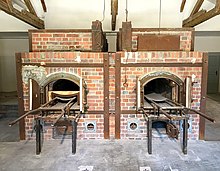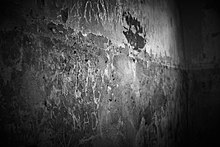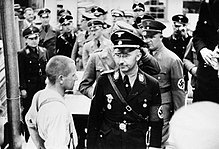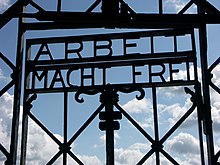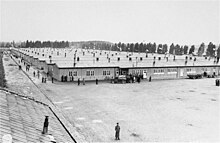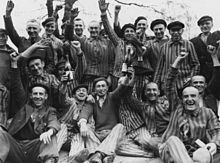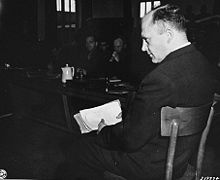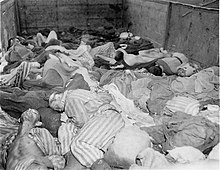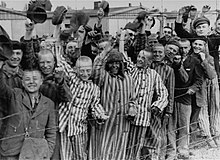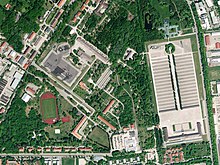| Dachau | |
|---|---|
| Concentration camp | |
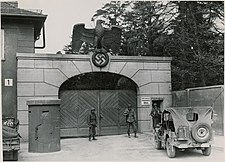
U.S. soldiers guarding the main entrance to Dachau just after liberation, 1945
| |
| Coordinates | 48°16′08″N 11°28′07″ECoordinates: 48°16′08″N 11°28′07″E |
| Location | Upper Bavaria, Southern Germany |
| Built by | Germany |
| Operated by | Schutzstaffel (SS) |
| Commandant | List of commandants |
| Original use | Political prison |
| Operational | 1933–1945 |
| Inmates | Political prisoners, Jews, homosexuals, Jehovah's Witnesses, Catholic priests, Communists, Romani |
| Number of inmates | Over 188,000 (estimated) |
| Killed | 41,500 (per Dachau website) |
| Liberated by | U.S. Army |
| Website | kz-gedenkstaette-dachau |
Dachau concentration camp (/ˈdɑːxaʊ/; German: Konzentrationslager (KZ) Dachau, IPA: [ˈdaxaʊ]) was the first of the Nazi concentration camps opened in 1933, intended to hold political prisoners. It is located on the grounds of an abandoned munitions factory northeast of the medieval town of Dachau, about 16 km (10 mi) northwest of Munich in the state of Bavaria, in southern Germany. Opened by Heinrich Himmler, its purpose was enlarged to include forced labor, and eventually, the imprisonment of Jews, German and Austrian criminals, and eventually foreign nationals from countries that Germany occupied or invaded. The Dachau camp system grew to include nearly 100 sub-camps, which were mostly work camps or Arbeitskommandos, and were located throughout southern Germany and Austria. The camps were liberated by U.S. forces on 29 April 1945.
Prisoners lived in constant fear of brutal treatment and terror detention including standing cells, floggings, the so-called tree or pole hanging, and standing at attention for extremely long periods. There were 32,000 documented deaths at the camp, and thousands that are undocumented.
Approximately 10,000 of the 30,000 prisoners were sick at the time of liberation.
In the postwar years the Dachau facility served to hold SS soldiers awaiting trial. After 1948, it held ethnic Germans who had been expelled from eastern Europe and were awaiting resettlement, and also was used for a time as a United States military base during the occupation. It was finally closed in 1960.
There are several religious memorials within the Memorial Site, which is open to the public.
General overview
Dachau served as a prototype and model for the other German
concentration camps that followed. Almost every community in Germany
had members taken away to these camps. Newspapers continually reported
"the removal of the enemies of the Reich to concentration camps." As
early as 1935, a jingle went around: "Lieber Herr Gott, mach mich stumm, Das ich nicht nach Dachau komm'" ("Dear God, make me silent, That I may not come to Dachau").
Aerial photo of the Dachau complex with the actual concentration camp on the left
The camp's layout and building plans were developed by Commandant Theodor Eicke
and were applied to all later camps. He had a separate secure camp near
the command center, which consisted of living quarters, administration,
and army camps. Eicke became the chief inspector for all concentration
camps, responsible for organizing others according to his model.
The Dachau complex included the prisoners' camp, which occupied
approximately 5 acres, and the much larger area of SS training school
including barracks, factories, plus other facilities of around 20 acres.
The entrance gate used by prisoners carries the phrase "Arbeit macht frei" (lit. "Work makes free", or "Work makes [one] free"; contextual English translation: "Work shall set you free"). This phrase was also used in Theresienstadt, near Prague, and Auschwitz I.
The camp commander gives a speech to prisoners about to be released as part of a pardoning action near Christmas 1933.
Dachau was the concentration camp that was in operation the longest
from March 1933 to April 1945, nearly all twelve years of the Nazi
regime. Dachau's close proximity to Munich, where Hitler came to power
and where the Nazi Party
had its official headquarters, made Dachau a convenient location. From
1933 to 1938, the prisoners were mainly German nationals detained for
political reasons. After the Reichspogromnacht or Kristallnacht,
30,000 male Jewish citizens were deported to concentration camps. More
than 10,000 of them were interned in Dachau alone. As the German
military occupied other European states, citizens from across Europe
were sent to concentration camps. Subsequently, the camp was used for
prisoners of all sorts, from every nation occupied by the forces of the
Third Reich.
In the postwar years, the camp continued in use. From 1945 through 1948, the camp was used by the Allies
as a prison for SS officers awaiting trial. After 1948, when hundreds
of thousands of ethnic Germans were expelled from eastern Europe, it
held Germans from Czechoslovakia until they could be resettled. It also
served as a military base for the United States, which maintained forces
in the country. It was closed in 1960. At the insistence of survivors,
various memorials have been constructed and installed here.
Two Dachau crematoriums
Demographic statistics vary but they are in the same general range.
History will likely never know how many people were interned or died
there, due to periods of disruption. One source gives a general estimate
of over 200,000 prisoners from more than 30 countries for the Third
Reich's years, of whom two-thirds were political prisoners, including
many Catholic priests, and nearly one-third were Jews. 25,613 prisoners
are believed to have died in the camp and almost another 10,000 in its
subcamps, primarily from disease, malnutrition and suicide. In late 1944, a typhus epidemic occurred in the camp caused by poor sanitation and overcrowding, which caused more than 15,000 deaths.
It was followed by an evacuation, in which large numbers of the
prisoners died. Toward the end of the war, death marches to and from the
camp caused the deaths of numerous unrecorded prisoners. After
liberation, prisoners weakened beyond recovery by the starvation
conditions continued to die.
Two thousand cases of "the dread black typhus" had already been
identified by 3 May, and the U.S. Seventh Army was "working day and
night to alleviate the appalling conditions at the camp".
Prisoners with typhus, a louse-borne disease with an incubation period
from 12 to 18 days, were treated by the 116th Evacuation Hospital, while
the 127th would be the general hospital for the other illnesses. There
were 227 documented deaths among the 2,252 patients cared for by the
127th.
Survivors of KZ Dachau demonstrate the operation of the crematorium by pushing a corpse into one of the ovens.
Over the 12 years of use as a concentration camp, the Dachau
administration recorded the intake of 206,206 prisoners and deaths of
31,951. Crematoria were constructed to dispose of the deceased. Visitors
may now walk through the buildings and view the ovens used to cremate
bodies, which hid the evidence of many deaths. It is claimed that in
1942, more than 3,166 prisoners in weakened condition were transported
to Hartheim Castle near Linz, and were executed by poison gas because they were deemed unfit.
The gas chamber
Inside a prison cell
Between January and April 1945 11,560 detainees died at KZ Dachau according to a U.S. Army report of 1945, though the Dachau administration registered 12,596 deaths from typhus at the camp over the same period.
Dachau was the third concentration camp to be liberated by British or American Allied forces.
History
Establishment
After the takeover of Bavaria on 9 March 1933, Heinrich Himmler, then Chief of Police
in Munich, began to speak with the administration of an unused
gunpowder and munitions factory. He toured the site to see if it could
be used for quartering protective-custody prisoners. The Concentration
Camp at Dachau was opened 22 March 1933, with the arrival of about 200
prisoners from Stadelheim Prison in Munich and the Landsberg fortress (where Hitler had written Mein Kampf during his imprisonment). Himmler announced in the Münchner Neuesten Nachrichten
newspaper that the camp could hold up to 5,000 people, and described it
as "the first concentration camp for political prisoners" to be used to
restore calm to Germany. It became the first regular concentration camp established by the coalition government of the National Socialist German Worker's Party (Nazi Party) and the German National People's Party (dissolved on 6 July 1933).
Jehovah's Witnesses, homosexuals, and emigrants were sent to Dachau after the 1935 passage of the Nuremberg Laws which institutionalized racial discrimination.
In early 1937, the SS, using prisoner labor, initiated construction of a
large complex capable of holding 6,000 prisoners. The construction was
officially completed in mid-August 1938. More political opponents, and over 11,000 German and Austrian Jews were sent to the camp after the annexation of Austria and the Sudetenland in 1938. Sinti and Roma in the hundreds were sent to the camp in 1939, and over 13,000 prisoners were sent to the camp from Poland in 1940.
Heinrich Himmler (front right, beside prisoner) inspecting Dachau Concentration Camp on 8 May 1936.
Forced labor
German concentration camps: Auschwitz, Oranienburg, Mauthausen and Dachau in "The Polish White Book", New York (1941).
The prisoners of Dachau concentration camp originally were to serve
as forced labor for a munition factory, and to expand the camp. It was
used as a training center for the SS-Totenkopfverbände guards and was a model for other concentration camps.
The camp was about 300 m × 600 m (1,000 ft × 2,000 ft) in rectangular
shape. The prisoners' entrance was secured by an iron gate with the
motto "Arbeit macht frei"
("Work will make you free"). This reflected Nazi propaganda, which
trivialized concentration camps as labor and re-education camps, when in
fact forced labor was used as a method of torture and murder.
As of 1938, the procedure for new arrivals occurred at the Schubraum, where prisoners were to hand over their clothing and possessions.
One former Luxembourgian prisoner, Albert Theis, reflected about the
room, "There we were stripped of all our clothes. Everything had to be
handed over: money, rings, watches. One was now stark naked".
The camp included an administration building that contained offices for the Gestapo
trial commissioner, SS authorities, the camp leader and his deputies.
These administration offices consisted of large storage rooms for the
personal belongings of prisoners, the bunker, roll-call square where
guards would also inflict punishment on prisoners (especially those who
tried to escape), the canteen where prisoners served SS men with
cigarettes and food, the museum containing plaster images of prisoners
who suffered from bodily defects, the camp office, the library, the
barracks, and the infirmary, which was staffed by prisoners who had
previously held occupations such as physicians or army surgeons.
Operation Barbarossa
Over 4,000 Soviet prisoners of war
were murdered by the Dachau commandant's guard at the SS shooting range
located two kilometers from the main camp in the years 1942/1943.
These murders were a clear violation of the provisions laid down in the
Geneva Convention for prisoners of war. The SS used the cynical term
"special treatment" for these criminal executions. The first executions
of the Soviet prisoners of war at the Hebertshausen shooting range took
place on 25 November 1941.
After 1942, the number of prisoners regularly held at the camp continued to exceed 12,000.
Dachau originally held Communists, leading Socialists and other
"enemies of the state" in 1933, but over time the Nazis began to send
German Jews to the camp. In the early years of imprisonment, Jews were
offered permission to emigrate overseas if they "voluntarily" gave their
property to enhance Hitler’s public treasury.
Once Austria was annexed and Czechoslovakia was defeated, the citizens
of both countries became the next prisoners at Dachau. In 1940, Dachau
became filled with Polish prisoners, who constituted the majority of the
prisoner population until Dachau was officially liberated.
The gate at the Jourhaus building through which the prisoner's camp was entered contains the slogan, Arbeit macht frei, or 'Work Sets You Free.'
The prisoner enclosure at the camp was heavily guarded to ensure that
no prisoners escaped. A 3-metre-wide (10 ft) no-man's land was the
first marker of confinement for prisoners; an area which upon entry
would elicit lethal gunfire from guard towers. Guards are known to have
tossed inmates' caps into this area, resulting in the death of the
prisoners when they attempted to retrieve the caps. Despondent prisoners
committed suicide by entering the zone. A four-foot-deep and eight-foot-broad (1.2 × 2.4 m) creek, connected with the river Amper,
lay on the west side between the "neutral-zone" and the electrically
charged, and barbed wire fence which surrounded the entire prisoner
enclosure.
In August 1944 a women's camp opened inside Dachau. In the last
months of the war, the conditions at Dachau deteriorated. As Allied
forces advanced toward Germany, the Germans began to move prisoners from
concentration camps near the front to more centrally located camps.
They hoped to prevent the liberation of large numbers of prisoners.
Transports from the evacuated camps arrived continuously at Dachau.
After days of travel with little or no food or water, the prisoners
arrived weak and exhausted, often near death. Typhus epidemics became a
serious problem as a result of overcrowding, poor sanitary conditions,
insufficient provisions, and the weakened state of the prisoners.
Owing to repeated transports from the front, the camp was
constantly overcrowded and the hygiene conditions were beneath human
dignity. Starting from the end of 1944 up to the day of liberation,
15,000 people died, about half of all the prisoners held at KZ Dachau.
Five hundred Soviet POWs were executed by firing squad. The first
shipment of women came from Auschwitz-Birkenau.
Final days
As late as 19 April 1945, prisoners were sent to KZ Dachau; on that date a freight train from Buchenwald
with nearly 4,500 was diverted to Nammering. SS troops and police
confiscated food and water, which local townspeople tried to give to the
prisoners. Nearly three hundred dead bodies were ordered removed from
the train and carried to a ravine over 400 metres (.25 mi) away. The 524
prisoners who had been forced to carry the dead to this site were then
shot by the guards, and buried along with those who had died on the
train. Nearly 800 bodies went into this mass grave.
"Grave of many thousand unknown."
During April 1945 as U.S. troops drove deeper into Bavaria, the commander of KZ Dachau suggested to Gestapo Chief Heinrich Himmler
that the camp be turned over to the Allies. Himmler, in signed
correspondence, prohibited such a move, adding that "No prisoners shall
be allowed to fall into the hands of the enemy alive."
On 24 April 1945, just days before the U.S. troops arrived at the
camp, the commandant and a strong guard forced between 6,000 and 7,000
surviving inmates – on a death march from Dachau south to Eurasburg, then eastwards towards the Tegernsee; liberated two days after Hitler's death by a Nisei-ethnicity U.S. Army artillery battalion. Any prisoners who could not keep up on the six-day march were shot. Many others died of exhaustion, hunger and exposure. Months later a mass grave containing 1,071 prisoners was found along the route.
Though at the time of liberation the death rate had peaked at 200
per day, after the liberation by U.S. forces the rate eventually fell
to between 50 and 80 deaths per day. In addition to the direct abuse of
the SS and the harsh conditions, people died from typhus epidemics and
starvation. The number of inmates had peaked in 1944 with transports
from evacuated camps in the east (such as Auschwitz), and the resulting
overcrowding led to an increase in the death rate.
Main camp
Purpose
Roll-call of Jewish prisoners (wearing Star of David badges), 20 July 1938
Dachau was opened in March 1933. The press statement given at the opening stated:
On Wednesday the first concentration camp is to be opened in Dachau with an accommodation for 5000 people. 'All Communists and—where necessary—Reichsbanner and Social Democratic functionaries who endanger state security are to be concentrated here, as in the long run it is not possible to keep individual functionaries in the state prisons without overburdening these prisons, and on the other hand these people cannot be released because attempts have shown that they persist in their efforts to agitate and organize as soon as they are released.
Between the years 1933 and 1945, more than 3.5 million Germans were
imprisoned in such concentration camps or prison for political reasons. Approximately 77,000 Germans were killed for one or another form of resistance by Special Courts, courts-martial,
and the civil justice system. Many of these Germans had served in
government, the military, or in civil positions, which were considered
to enable them to engage in subversion and conspiracy against the Nazis.
Organization
The camp was divided into two sections: the camp area and the crematorium.
The camp area consisted of 32 barracks, including one for clergy
imprisoned for opposing the Nazi regime and one reserved for medical
experiments. The courtyard between the prison and the central kitchen
was used for the summary execution of prisoners. The camp was surrounded
by an electrified barbed-wire gate, a ditch, and a wall with seven
guard towers.
Prisoners' barracks in 1945
In early 1937, the SS,
using prisoner labor, initiated construction of a large complex of
buildings on the grounds of the original camp. The construction was
officially completed in mid-August 1938 and the camp remained
essentially unchanged and in operation until 1945. A crematorium that
was next to, but not directly accessible from within the camp, was
erected in 1942. KZ Dachau was therefore the longest running
concentration camp of the Third Reich. The Dachau complex included other
SS facilities beside the concentration camp—a leader school of the
economic and civil service, the medical school of the SS, etc. The camp
at that time was called a "protective custody camp," and occupied less
than half of the area of the entire complex.
Medical experimentation
Hundreds of prisoners suffered and died, or were executed in medical experiments conducted at KZ Dachau, for which Sigmund Rascher
was in charge. Hypothermia experiments involved exposure to vats of icy
water or being strapped down naked outdoors in freezing temperatures.
Attempts at reviving the subjects included scalding baths, and forcing
naked women to copulate with the unconscious victim. Nearly 100
prisoners died during these experiments. The original records of the experiments were destroyed "in an attempt to conceal the atrocities".
Extensive communication between the investigators and Heinrich Himmler, head of the SS, documents the experiments.
During 1942 high altitude experiments were conducted. Victims
were subjected to rapid decompression to pressures found at 4,300 metres
(14,100 ft) and experienced spasmodic convulsions, agonal breathing, and eventual death.
Demographics
The
camp was originally designed for holding German and Austrian political
prisoners and Jews, but in 1935 it began to be used also for ordinary
criminals. Inside the camp there was a sharp division between the two
groups of prisoners; those who were there for political reasons and
therefore wore a red tag, and the criminals, who wore a green tag.
The political prisoners who were there because they disagreed with Nazi
Party policies, or with Hitler, naturally did not consider themselves
criminals. Dachau was used as the chief camp for Christian (mainly
Catholic) clergy who were imprisoned for not conforming with the Nazi
Party line.
Polish
prisoners in Dachau toast their liberation from the camp. Poles
constituted the largest ethnic group in the camp during the war,
followed by Russians, French, Yugoslavs, Jews, and Czechs.
During the war, other nationals were transferred to it, including
French; in 1940 Poles; in 1941 people from the Balkans, Czechs,
Yugoslavs; and in 1942, Russians.
Prisoners were divided into categories. At first, they were
classified by the nature of the crime for which they were accused, but
eventually were classified by the specific authority-type under whose
command a person was sent to camp. Political prisoners who had been arrested by the Gestapo wore a red badge, "professional" criminals sent by the Criminal Courts wore a green badge, Cri-Po prisoners arrested by the criminal police wore a brown badge, "work-shy and asocial" people sent by the welfare authorities or the Gestapo wore a black badge, Jehovah's Witnesses
arrested by the Gestapo wore a violet badge, homosexuals sent by the
criminal courts wore a pink badge, emigrants arrested by the Gestapo
wore a blue badge, "race polluters" arrested by the criminal court or
Gestapo wore badges with a black outline, second-termers arrested by the
Gestapo wore a bar matching the color of their badge, "idiots" wore a
white armband with the label Blöd (Stupid), and Jews, whose incarceration in the Dachau concentration camp dramatically increased after Kristallnacht, wore a yellow badge, combined with another color.
The average number of Germans in the camp during the war was
3,000. Just before the liberation many German prisoners were evacuated,
but 2,000 of these Germans died during the evacuation transport.
Evacuated prisoners included such prominent political and religious
figures as Martin Niemöller, Kurt von Schuschnigg, Édouard Daladier, Léon Blum, Franz Halder, and Hjalmar Schacht.
Clergy
In effort to counter the strength and influence of spiritual resistance, Nazi security services monitored clergy very closely.
Priests were frequently denounced, arrested and sent to concentration
camps, often simply on the basis of being "suspected of activities
hostile to the State" or that there was reason to "suppose that his
dealings might harm society".
Despite SS hostility to religious observance, the Vatican and German
bishops successfully lobbied the regime to concentrate clergy at one
camp and obtained permission to build a chapel, for the priests to live
communally and for time to be allotted to them for the religious and
intellectual activity. Priests Barracks
at Dachau were established in Blocks 26, 28 and 30, though only
temporarily. 26 became the international block and 28 was reserved for
Poles – the most numerous group.
Of a total of 2,720 clergy recorded as imprisoned at Dachau, the
overwhelming majority, some 2,579 (or 94.88%) were Catholic. Among the
other denominations, there were 109 Protestants, 22 Greek Orthodox, 8
Old Catholics and Mariavites and 2 Muslims. In his Dachau: The Official History 1933–1945, Paul Berben noted that R. Schnabel's 1966 investigation, Die Frommen in der Hölle
("The Pious Ones in Hell") found an alternative total of 2,771 and
included the fate all the clergy listed, with 692 noted as deceased and
336 sent out on "invalid trainloads" and therefore presumed dead. Over 400 German priests were sent to Dachau.
Total numbers incarcerated are nonetheless difficult to assert, for
some clergy were not recognised as such by the camp authorities, and
some—particularly Poles—did not wish to be identified as such, fearing
they would be mistreated.
The Nazis introduced a racial hierarchy—keeping Poles in harsh conditions, while favoring German priests.
697 Poles arrived in December 1941, and a further 500 of mainly elderly
clergy were brought in October the following year. Inadequately clothed
for the bitter cold, of this group only 82 survived. A large number of
Polish priests were chosen for Nazi medical experiments. In November
1942, 20 were given phlegmons.
120 were used by Dr Schilling for malaria experiments between July 1942
and May 1944. Several Poles met their deaths with the "invalid trains"
sent out from the camp, others were liquidated in the camp and given
bogus death certificates. Some died of cruel punishment for
misdemeanors—beaten to death or run to exhaustion.
Staff
The camp staff consisted mostly of SS males, although 19 female guards served at Dachau as well, most of them until liberation.
Sixteen have been identified including Fanny Baur, Leopoldine
Bittermann, Ernestine Brenner, Anna Buck, Rosa Dolaschko, Maria Eder,
Rosa Grassmann, Betty Hanneschaleger, Ruth Elfriede Hildner, Josefa Keller, Berta Kimplinger, Lieselotte Klaudat, Theresia Kopp, Rosalie Leimboeck, and Thea Miesl. Women guards were assigned also to the Augsburg Michelwerke, Burgau, Kaufering,
Mühldorf, and Munich Agfa Camera Werke subcamps. In mid-April 1945,
female subcamps at Kaufering, Augsburg, and Munich were closed, and the
SS stationed the women at Dachau. Several Norwegians worked as guards at
the Dachau camp.
In the major Dachau war crimes case (United States of America v. Martin Gottfried Weiss et.al.),
forty-two officials of Dachau were tried from November to December
1945. All were found guilty – thirty-six of the defendants were
sentenced to death on 13 December 1945, of whom 23 were hanged on 28–29
May 1946, including the commandant, SS-Obersturmbannführer Martin Gottfried Weiss, SS-Obersturmführer Freidrich Wilhelm Ruppert and camp doctors Karl Schilling and Fritz Hintermeyer.
Camp commandant Weiss admitted in affidavit testimony that most of the
deaths at Dachau during his administration were due to "typhus, TB,
dysentery, pneumonia, pleurisy, and body weakness brought about by lack
of food." His testimony also admitted to deaths by shootings, hangings
and medical experiments.
Ruppert ordered and supervised the deaths of innumerable prisoners at
Dachau main and subcamps, according to the War Crimes Commission
official trial transcript. He testified about hangings, shootings and
lethal injections, but did not admit to direct responsibility for any
individual deaths. An anonymous Dutch prisoner contended that British Special Operations Executive (SOE) agent Noor Inayat Khan was cruelly beaten by SS officer Wilhelm Ruppert before being shot from behind; the beating may have been the actual cause of her death.
Satellite camps and sub-camps
Satellite camps under the authority of Dachau were established in the
summer and autumn of 1944 near armaments factories throughout southern
Germany to increase war production. Dachau alone had more than 30 large
subcamps, and hundreds of smaller ones, in which over 30,000 prisoners worked almost exclusively on armaments.
Overall, the Dachau concentration camp system included 123
sub-camps and Kommandos which were set up in 1943 when factories were
built near the main camp to make use of forced labor of the Dachau
prisoners. Out of the 123 sub-camps, eleven of them were called
Kaufering, distinguished by a number at the end of each. All Kaufering
sub-camps were set up to specifically build three underground factories
(Allied bombing raids made it necessary for them to be underground) for a
project called Ringeltaube (wood pigeon), which planned to be
the location in which the German jet fighter plane, Messerschmitt Me
262, was to be built. In the last days of war, in April 1945, the
Kaufering camps were evacuated and around 15,000 prisoners were sent up
to the main Dachau camp. Typhus alone was estimated to have caused
15,000 deaths between December 1944 and April 1945.
"Within the first month after the arrival of the American troops,
10,000 prisoners were treated for malnutrition and kindred diseases. In
spite of this one hundred prisoners died each day during the first month
from typhus, dysentery or general weakness".
As U.S. Army troops neared the Dachau sub-camp at Landsberg
on 27 April 1945, the SS officer in charge ordered that 4,000 prisoners
be murdered. Windows and doors of their huts were nailed shut. The
buildings were then doused with gasoline and set afire. Prisoners who
were naked or nearly so were burned to death, while some managed to
crawl out of the buildings before dying. Earlier that day, as Wehrmacht
troops withdrew from Landsberg am Lech, towns people hung white sheets
from their windows. Infuriated SS troops dragged German civilians from
their homes and hanged them from trees.
Liberation
Main camp
Female prisoners at Dachau wave to their liberators
As the Allies began to advance on Nazi Germany, the SS began to evacuate the first concentration camps in summer 1944.
Thousands of prisoners were killed before the evacuation due to being
ill or unable to walk. At the end of 1944, the overcrowding of camps
began to take its toll on the prisoners. The unhygienic conditions and
the supplies of food rations became disastrous. In November a typhus
fever epidemic broke out that took thousands of lives.
In the second phase of the evacuation, in April 1945, Himmler
gave direct evacuation routes for remaining camps. Prisoners who were
from the northern part of Germany were to be directed to the Baltic and
North Sea coasts to be drowned. The prisoners from the southern part
were to be gathered in the Alps, which was the location in which the SS
wanted to resist the Allies.
On 28 April 1945, an armed revolt took place in the town of Dachau.
Both former and escaped concentration camp prisoners, and a renegade Volkssturm
(civilian militia) company took part. At about 8:30 am the rebels
occupied the Town Hall. The advanced forces of the SS gruesomely
suppressed the revolt within a few hours.
Bodies in the Dachau death train
SS men confer with General Henning Linden (person with helmet, looking to his right) during the liberation of the Dachau concentration camp (April 29, 1945)
Being fully aware that Germany was about to be defeated in World War
II, the SS invested its time in removing evidence of the crimes it
committed in the concentration camps. They began destroying
incriminating evidence in April 1945 and planned on murdering the
prisoners using codenames "Wolke A-I" (Cloud A-1) and "Wolkenbrand"
(Cloud fire).
However, these plans were not carried out. In mid-April, plans to
evacuate the camp started by sending prisoners toward Tyrol. On 26
April, over 10,000 prisoners were forced to leave the Dachau
concentration camp on foot, in trains, or in trucks. The largest group
of some 7,000 prisoners was driven southward on a foot-march lasting
several days. More than 1,000 prisoners did not survive this march. The
evacuation transports cost many thousands of prisoners their lives.
On 26 April 1945 prisoner Karl Riemer fled the Dachau
concentration camp to get help from American troops and on 28 April
Victor Maurer, a representative of the International Red Cross,
negotiated an agreement to surrender the camp to U.S. troops. That night
a secretly formed International Prisoners Committee took over the
control of the camp. Units of 3rd Battalion, 157th Infantry Regiment,
45th Infantry Division, commanded by Lieutenant Colonel Felix L. Sparks, were ordered to secure the camp. On 29 April Sparks led part of his battalion as they entered the camp over a side wall. At about the same time, Brigadier General Henning Linden led the 222nd Infantry Regiment of the 42nd (Rainbow) Infantry Division soldiers including his aide, Lieutenant William Cowling,
to accept the formal surrender of the camp from German Lieutenant
Heinrich Wicker at an entrance between the camp and the compound for the
SS garrison. Linden was traveling with Marguerite Higgins
and other reporters, as a result, Linden's detachment generated
international headlines by accepting the surrender of the camp. More
than 30,000 Jews and political prisoners were freed, and since 1945
adherents of the 42nd and 45th Division versions of events have argued
over which unit was the first to liberate Dachau.
Satellite camps liberation
The first Dachau subcamp discovered by advancing Allied forces was Kaufering Lager IV at Landsberg am Lech by the 12th Armored Division on 27 April 1945. Subcamps liberated by the 12th Armored Division included: Hurlach, Erpting, Kaufering, Schrobenhausen, Schwabing, Langerringen, Türkheim, Lauingen, Schwabach, Germering.
SS
officer Johann Baptist Eichelsdörfer, April 1945, Commandant of
Kaufering IV Konzentrationslager, Landsberg [Executed 29 May 1946
Landsberg].
During the liberation of the sub-camps surrounding Dachau, advance scouts of the U.S. Army's 522nd Field Artillery Battalion, a segregated battalion consisting of Nisei, 2nd generation Japanese-Americans, liberated the 3,000 prisoners of the "Kaufering IV Hurlach" slave labor camp. Perisco describes an Office of Strategic Services
(OSS) team (code name LUXE) leading Army Intelligence to a "Camp IV" on
29 April. "They found the camp afire and a stack of some four hundred
bodies burning ... American soldiers then went into Landsberg
and rounded up all the male civilians they could find and marched them
out to the camp. The former commandant was forced to lie amidst a pile
of corpses. The male population of Landsberg was then ordered to walk
by, and ordered to spit on the commandant as they passed. The commandant
was then turned over to a group of liberated camp survivors". The 522nd's personnel later discovered the survivors of a death march headed generally southwards from the Dachau main camp to Eurasburg, then eastwards towards the Austrian border on 2 May, just west of the town of Waakirchen.
Weather at the time of liberation was unseasonably cool and
temperatures trended down through the first two days of May; on 2 May,
the area received a snowstorm with 10 centimetres (4 in) of snow at
nearby Munich. Proper clothing was still scarce and film footage from the time (as seen in The World at War) shows naked, gaunt people either wandering on snow or dead under it.
Due to the number of sub-camps over a large area that comprised
the Dachau concentration camp complex, many Allied units have been
officially recognized by the United States Army Center of Military History and the United States Holocaust Memorial Museum as liberating units of Dachau, including:
the 4th Infantry Division, 36th Infantry Division, 42nd Infantry Division, 45th Infantry Division, 63rd Infantry Division, 99th Infantry Division, 103rd Infantry Division, 10th Armored Division, 12th Armored Division, 14th Armored Division, 20th Armored Division, and the 101st Airborne Division.
Killing of camp guards
Photograph
allegedly showing an unauthorized execution of SS troops in a coal yard
in the area of the Dachau concentration camp during its liberation—part
of the Dachau liberation reprisals. 29 April 1945 (U.S. Army photograph)
American troops killed some of the camp guards after they had
surrendered. The number is disputed as some were killed in combat, some
while attempting to surrender, and others after their surrender was
accepted. In 1989 Brigadier General Felix L. Sparks, the Colonel in
command of a battalion that was present, stated:
The total number of German guards killed at Dachau during that day most certainly does not exceed fifty, with thirty probably being a more accurate figure. The regimental records of the 157th Field Artillery Regiment for that date indicate that over a thousand German prisoners were brought to the regimental collecting point. Since my task force was leading the regimental attack, almost all the prisoners were taken by the task force, including several hundred from Dachau.
An Inspector General report resulting from a US Army investigation
conducted between 3 and 8 May 1945 and titled, "American Army
Investigation of Alleged Mistreatment of German Guards at Dachau," found
that 21 plus "a number" of presumed SS men were killed with others
being wounded after their surrender had been accepted. In addition, 25 to 50 SS guards were estimated to have been killed by the liberated prisoners. Lee Miller visited the camp just after liberation, and photographed several guards who were killed by soldiers or prisoners.
According to Sparks, court-martial charges were drawn up against him and several other men under his command but General George S. Patton, who had recently been appointed military governor of Bavaria, chose to dismiss the charges.
Colonel Charles L. Decker, an acting deputy judge advocate,
concluded in late 1945 that, while war crimes had been committed at
Dachau by Germany, "Certainly, there was no such systematic criminality
among United States forces as pervaded the Nazi groups in Germany."
American troops also forced local citizens to the camp to see for themselves the conditions there and to help bury the dead. Many local residents were shocked about the experience and claimed no knowledge of the activities at the camp.
Post-liberation Easter
6
May 1945 (23 April on the Orthodox calendar) was the day of Pascha,
Orthodox Easter. In a cell block used by Catholic priests to say daily
Mass, several Greek, Serbian and Russian priests and one Serbian deacon,
wearing makeshift vestments made from towels of the SS guard, gathered
with several hundred Greek, Serbian and Russian prisoners to celebrate
the Paschal Vigil. A prisoner named Rahr described the scene:
Liberated Dachau camp prisoners cheer U.S. troops
In the entire history of the Orthodox Church there has probably never been an Easter service like the one at Dachau in 1945. Greek and Serbian priests together with a Serbian deacon adorned the make-shift 'vestments' over their blue and gray-striped prisoners' uniforms. Then they began to chant, changing from Greek to Slavic, and then back again to Greek. The Easter Canon, the Easter Sticheras—everything was recited from memory. The Gospel—In the beginning was the Word—also from memory. And finally, the Homily of Saint John—also from memory. A young Greek monk from the Holy Mountain stood up in front of us and recited it with such infectious enthusiasm that we shall never forget him as long as we live. Saint John Chrysostomos himself seemed to speak through him to us and to the rest of the world as well!
There is a Russian Orthodox chapel at the camp today, and it is well
known for its icon of Christ leading the prisoners out of the camp
gates. The U.S. 7th Army's version of the events of the Dachau
Liberation is available in Report of Operations of the Seventh United States Army, Vol. 3, page 382.
After liberation
Authorities worked night and day to alleviate conditions at the camp
immediately following the liberation as an epidemic of black typhus
swept through the prisoner population. Two thousand cases had already
been reported by that 3 May.
By October of the same year the camp was being used by the U.S.
Army as a place of confinement for war criminals, the SS and important
witnesses. It was also the site of the Dachau Trials
for German war criminals, a site chosen for its symbolism. In 1948 the
Bavarian government established housing for refugees on the site, and
this remained for many years. Among those held in the Dachau internment camp set up under the U.S. Army were Elsa Ehrich, Maria Mandl, and Elisabeth Ruppert.
Deportation of Soviet nationals
By
January 1946, 18,000 members of the SS were being confined at the camp
along with an additional 12,000 persons, including deserters from the
Russian army. The occupants of one barracks rioted as 271 of the Russian
deserters were to be loaded onto trains that would return them to
Russian-controlled lands, as agreed at the Yalta Conference.
Ten of the soldiers, who had been captured in German Army uniforms,
committed suicide during the riot. Twenty-one others attempted suicide,
apparently with razor blades. Many had "cracked heads" inflicted by 500
American and Polish guards, in the attempt to bring the situation under
control. Inmates barricaded themselves inside and set fire to the
building, tore off their clothing, and linked arms to resist being
removed from the building. Some begged American soldiers to shoot them.
Tear gas was used by the soldiers before rushing the building.
There were 275 cases of suicide or attempted suicide, whether by
hanging, smashing window panes and cutting their throats on the shards
of glass, or throwing themselves into the flames of their burning
barracks.
The Kaserne quarters and other buildings used by the guards and
trainee guards were converted and served as the Eastman Barracks, an
American military post, for many years. It had its own elementary
school: Dachau American Elementary School, a part of the U.S. Department of Defense dependent school system.
After the closure of the Eastman Barracks, these areas are now occupied by the Bavarian Bereitschaftspolizei (rapid response police unit).
List of personnel
Adolf Eichmann on trial in 1961
Commandants
- SS-Standartenführer Hilmar Wäckerle (22 March 1933 – 26 June 1933)
- SS-Gruppenführer Theodor Eicke (26 June 1933 – 4 July 1934)
- SS-Oberführer Alexander Reiner (4 July 1934 – 22 October 1934)
- SS-Brigadeführer Berthold Maack (22 October 1934 – 12 January 1935)
- SS-Oberführer Heinrich Deubel (12 January 1935 – 31 March 1936)
- SS-Oberführer Hans Loritz (31 March 1936 – 7 January 1939)
- SS-Hauptsturmführer Alexander Piorkowski (7 January 1939 – 2 January 1942)
- SS-Obersturmbannführer Martin Weiß (3 January 1942 – 30 September 1943)
- SS-Hauptsturmführer Eduard Weiter (30 September 1943 – 26 April 1945)
- SS-Obersturmbannführer Martin Weiß (26 April 1945 – 28 April 1945)
- SS-Untersturmführer Johannes Otto (28 April 1945)
- SS-Untersturmführer Heinrich Wicker (28 April 1945 – 29 April 1945)
Other staff
- Adolf Eichmann (29 January 1934 – October 1934) (Eichmann claimed that his unit had nothing to do with the concentration camp)
- Rudolf Höss (1934–1938)
- Max Kögel (1937–1938)
- Gerhard Freiherr von Almey, a SS-Obergruppenführer, half-brother of Ludolf von Alvensleben. Executed in 1955, in Moscow.
- Johannes Heesters (visited the camp and entertained the SS-officers, was also given/giving tours)
- Otto Rahn (1937)
SS and civilian doctors
Dr. Hans Eisele in American internment
- SS-Untersturmführer – Dr. Hans Eisele – (13 March 1912 – 1967) – Escaped to Egypt
- SS-Obersturmführer – Dr. Fritz Hintermayer – (28 Oct 1911 – 29 May 1946) – Executed by the Allies
- Dr. Ernst Holzlöhner – (Committed suicide)
- SS-Hauptsturmführer – Dr. Fridolin Karl Puhr – (30 April 1913 – ?) – Sentenced to death, later commuted to 10-years imprisonment
- SS-Untersturmführer Dr. Sigmund Rascher – (12 February 1909 – 26 April 1945) – Executed by the SS
- Dr. Claus Schilling – (25 July 1871 – 28 May 1946) – Executed by the Allies
- SS Sturmbannführer – Dr. Horst Schumann – (11 May 1906 – 5 May 1983) – Escaped to Ghana, later extradited to West Germany
- SS Obersturmführer – Dr. Helmuth Vetter – (21 March 1910 – 2 February 1949) – Executed by the Allies
- SS Sturmbannführer – Dr. Wilhelm Witteler – (20 April 1909 – ?) – Sentenced to death, later commuted to 20-years imprisonment
- SS Sturmbannführer – Dr. Waldemar Wolter – (19 May 1908 – 28 May 1947) – Executed by the Allies
Memorial
Memorial sculpture by Nandor Glid erected in 1968
Orthodox chapel in the memorial.
Aerial photo of the memorial in 2012
Between 1945 and 1948 when the camp was handed over to the Bavarian
authorities, many accused war criminals and members of the SS were
imprisoned at the camp.
Owing to the severe refugee crisis mainly caused by the expulsions of ethnic Germans,
the camp was from late 1948 used to house 2000 Germans from
Czechoslovakia (mainly from the Sudetenland). This settlement was called
Dachau-East, and remained until the mid-1960s.
During this time, former prisoners banded together to erect a memorial
on the site of the camp, finding it unbelievable that there were still
people (refugees) living in the former camp.
The display, which was reworked in 2003, takes the visitor
through the path of new arrivals to the camp. Special presentations of
some of the notable prisoners are also provided. Two of the barracks
have been rebuilt and one shows a cross-section of the entire history of
the camp, since the original barracks had to be torn down due to their
poor condition when the memorial was built. The other 32 barracks are
indicated by concrete foundations. The memorial includes four chapels
for the various religions represented among the prisoners.
In media
- In his 2013 autobiography, Moose: Chapters from My Life, in the chapter entitled, "Dachau", author Robert B. Sherman chronicles his experiences as an American Army serviceman during the initial hours of Dachau's liberation.
- In Lewis Black's first book, Nothing's Sacred, he mentions visiting the camp as part of his tour of Europe and how it looked all cleaned up and spiffy, "like some delightful holiday camp", and only the crematorium building showed any sign of the horror that went on there.
- In Maus, Vladek describes his time interned at Dachau, among his time at other concentration camps. He describes the journey to Dachau in over-crowded trains, trading rations for other goods and favors to stay alive, and contracting typhus.
- Frontline: "Memory of the Camps" (7 May 1985, Season 3, Episode 18), is a 56-minute television documentary that addresses Dachau and other Nazi concentration camps




